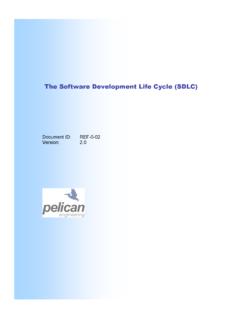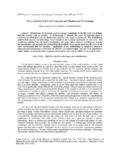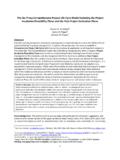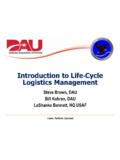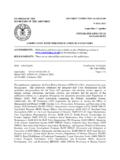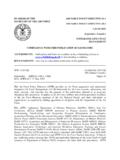Transcription of Tourism development and the tourism area life …
1 Tourism Management](]]]])]]] ]]] Tourism development and the Tourism area life - cycle model:A case study of zhangjiajie national forest park , ChinaLinsheng Zhonga, , Jinyang Dengb, Baohui XiangcaInstitute of Geographical Sciences and Natural Resources Research, Chinese Academy of Sciences, Beijing 100101, ChinabRecreation, Parks, and Tourism Resources Program, West Virginia University, Morgantown, WV 26506, USAcDepartment of Human Resources, China Woman s University, Beijing 100101, ChinaReceived 28 June 2006.
2 Accepted 10 October 2007 AbstractThe conceptual framework of the Tourism Area life cycle (TALC) has been frequently examined since it was first proposed by Butlerin 1980. However, few studies have applied the concept to national parks and other protected areas. This paper examines the applicabilityof the model to China s zhangjiajie national forest park . In addition, both external and internal factors affecting the park s tourismdevelopment as well as the environmental, social, and economic changes of the area are also discussed.
3 Results indicate that the park hasexperienced the first four stages as described in Butler s 1980 seminal paper [The concept of a tourist area cycle of evolution: Implicationsfor management of Geographer,24, 5 12]. Currently, the park is in the consolidation stage. Both governments andthe private sector are major players as catalysts for the park s Tourism development from one stage to the next. While the local or evenregional economy has become increasingly dependent on Tourism , the park has also been experiencing noticeable transformation and lossof traditional cultures since its inception in 1982.
4 Finally limitations to the current paper are Elsevier Ltd. All rights : national forest parks; Tourism development ; China; Tourism life - cycle model1. IntroductionThe conceptual framework of the Tourism Area LifeCycle (TALC) has been frequently examined since it wasfirst proposed by Butler in 1980. The recent edited twovolumes on the model (Butler, 2006a, 2006b) furtherhighlights its significance as one of the most used frame-works within Tourism (2006), in review-ing previous studies, listed a total of 49 major works relatedto the TALC.
5 These studies have examined the model atdifferent units of analysis, ranging from a single touristresource ( , Niagara Falls,Getz, 1992) to a destinationof varied features ( , Lancaster County,Hovinen, 1981;Hovinen, 2002; Canada s NW Territories,Keller, 1987; theGreater Yellowstone region,Johnson & Snepenger, 1993;and the Smoky Mountain region,Tooman, 1997). Inaddition, the model has also been applied to differing typesof Tourism attractions and resources ( , islands, costalresorts/beaches, mountainous destinations, etc.)
6 And fromdifferent perspectives ( , the validity and applicability ofthe TALC,Agarwal, 1997; social, environmental and/oreconomic changes as they relate to each stage of the model,Berry, 2001;Hovinen, 2002;Tooman, 1997; and tourismplanning,Bao & Zhang, 2006;Getz, 1992; etc.). TheTALC, as examined in these studies, was generally provento be a useful framework in explaining the dynamics oftourism development for a resort, although a universalconsensus about its validity and applicability has not yetbeen , more studies need to be conducted to test themodel (Agarwal, 1997;Berry, 2001) and asButler (2006a,2006b)pointed out in his concluding chapter in the twovolumes, an understanding [of the way that touristdestinations develop] is still far from complete (p.)
7 286).The authors of this paper would argue that specialattention should be paid to areas to which the model hasARTICLE IN $ - see front matterr2007 Elsevier Ltd. All rights Corresponding author. Tel.: +86 10 64889033; fax: +86 10 (L. (J. (B. Xiang).Please cite this article as: Zhong, L., et al. Tourism development and the Tourism area life - cycle model: A case study of zhangjiajie national ForestPark, Management(2007), rarely applied ( , national parks or other peripheralareas), particularly those in developing countries with arapid economic growth.)
8 A number of reasons prompt thisobservation. First, the majority of existing studies are ofcoastal/island destinations with few being focused onnational parks and other protected areas (albeit there aretwo exceptions, ,Boyd, 2006;Weizenegger, 2006). Yetparks are important places for the protection of ecologicalsystems and natural resources as well as for the provisionof recreational and Tourism opportunities for the is particularly true for those areas assigned WorldHeritage status (Boyd, 2006). Because of the nature ofthese areas, governmental interventions could affect thedirection and speed of Tourism development for theseplaces more than in the case of an island resort(Weizenegger, 2006).
9 Second, the robustness of the modelhas been tested primarily in North America, UK, andMediterranean areas where Tourism development has along history and has obtained its existing situation over anextended period of development (Baum, 1998).Relatively few studies have been undertaken in develop-ing countries where newly emerging Tourism destinationsmight reach the maturity stage within a short time periodas noted byBaum (1998, p. 169; also see Baum, 2006):It is arguable that the model has rather less value, exceptperhaps of a cautionary nature, to newly emergingtourism destinations, particularly in the developingworld.
10 Here the development period is likely to havebeen much more rapid and, with the added force ofglobalisation and multi- national investment, may wellhave jumped one or more stages within the ,Johnson and Snepenger (2006)also emphasizedthat more studies should be conducted of yother settingswithydifferent economic transitionsy, which could allprovide valuable insight into the changing nature oftourism impacts and destination maturation processes (p. 234). China, the world s largest developing country withthe fastest economic growth, could provide such a settingin which the development processes of a newly emergingtourism destination in a remote and underdeveloped regioncan be analyzed in relation to the macroeconomic changein the whole response to the above concerns, this paper applies theTALC to China s first national forest park ZhangjiajieNational forest park (ZNFP).

